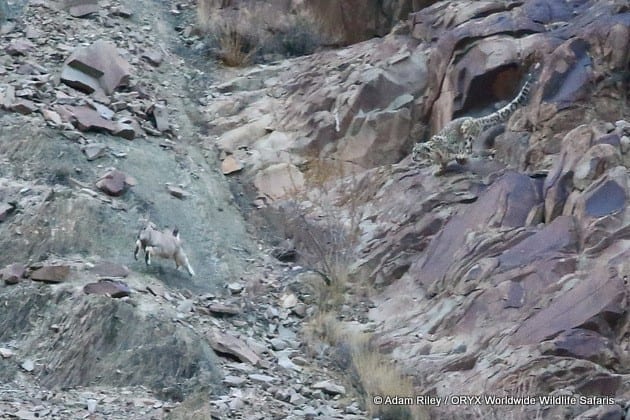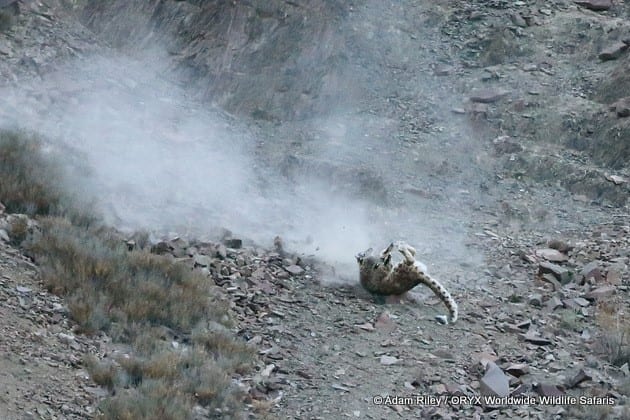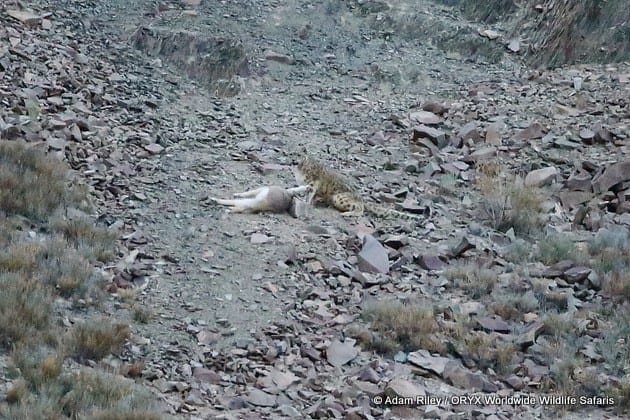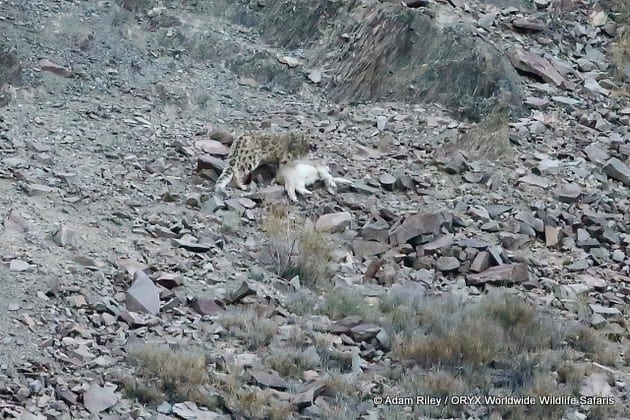Suddenly the Snow Leopard detected the presence of its prey and sat up on its haunches for the first time since we had relocated it. It began to bob its head from side to side, a clear feline sign of measuring distance and perspective in planning an attack. We could not believe our fortune, could we really be treated to a Snow Leopard hunt – this was beyond our wildest dreams? Then the leopard was moving and it headed along the top of the outcrop, disappearing on the hidden slope opposite to where the sheep were grazing.

Two minutes later it appeared half way down the outcrop and slightly above the Blue Sheep. First it sat up trying to relocate its prey and once locked on, the cat slunk low and crept into a fault line that ran across the outcrop towards the sheep. Half way across the rocks, it sunk into a hollow, just the top of its head visible as it kept a careful watch. The two adult sheep now began moving away from the attack zone, did they have an instinct that danger was near, or did they know from experience not to dally near rocks where leopards might lie in wait?

However the young sheep carried on oblivious heading higher up the slope along the edge of the outcrop, and closer and closer to the hidden Snow Leopard. By this stage we were all at our wits end and shaking with excitement, was the Snow Leopard going to charge, why was it taking soooooo long? My shoulders were aching with the effort of holding my camera ready for the pounce.

And finally in a blur, everything happened. The Snow Leopard leapt from its cover, bounding across the rocks in great leaps towards the young Blue Sheep. All three sheep took to flight, creating dust trails in their wake. The speed at which the Snow Leopard closed ground on the young sheep was remarkable as it barreled off the rocky outcrop to open ground, clearing a large rock en route.



Within seconds the Snow Leopard was on the hapless sheep. After careful scrutiny of images, it seems that the Blue Sheep lost its footing as it tried to escape but in the process it kicked up a load of gravel and dust, right into the Snow Leopard’s face, temporarily blinding the cat. This gave the sheep a vital break and it was able to pull away from the leopard which kept at its heels but was several critical paces behind.

The two adult sheep had gone their separate ways, one heading downhill away from the danger and the other, possibly the younger sheep’s mother, scrambling up a steep slope. At this point, our young sheep made a tactical error and instead of fleeing downslope, it tried to follow the upper sheep.

The slope became incredibly steep, almost vertical, and this gave the Snow Leopard its chance to gain ground on its shorter legged target.


Finally, the young sheep realized the leopard was almost upon it and bravely pulled a u-turn, heading back down the slope in the direction from which it had come. Snow Leopards have extremely long tails, up to a meter in length and besides storing fat, the tail is utilized as a ‘scarf’ in the winter. This tail is also a valuable rudder and balancing device, thus the Snow Leopard was easily able to perform its own abrupt u-turn and track the sheep back down the slope.

The young sheep cleared a massive jump, but it was the beginning of the end as it could not match the 15m (50ft) jumps that a Snow Leopard can achieve, and within moments the cat was right on its heels.

Extending a paw, the Snow Leopard seemed to ankle-tap the sheep and as it rolled, the cat leapt onto sheep and immediately latched onto its throat. This take at such high speed and on a steep slope meant gravity took its affect and the cat and sheep tumbled over and over each other until the Snow Leopard took control of the situation. The Snow Leopards’ thick pelts have long been highly sought-after artifacts by the people who share its Central Asian range, providing amazing insulation in the cold, but another reason their pelts are so thick must be to protect the leopard when it takes rough tumbles across its rugged, rocky environment.

For at least 3 minutes the Snow Leopard lay alongside the young sheep, firmly attached to its throat as it suffocated its prey, the Blue Sheep feebly kicking its hind legs intermittently.

Only when it was certain the sheep was dead did our predator finally release its fatal grip and rest alongside its upcoming meal for several minutes, catching its breath after such an extreme effort. For the first time in minutes, the Snow Leopard became aware of us again, ensuring we had not moved and were posing no threat on the opposite slope.

Finally the Snow Leopard picked up the Blue Sheep and dragged it across the open area, pretty much following the route of the chase, back to the fault line in the rocks and finally over the rocky outcrop and out of our view where presumably it feasted on its well-deserved meal!

The Snow Leopard drags the sheep across the rocky outcrop and out of view of the observers before it begins to feed
By this time the light was fading fast and we arrived back in camp half an hour later in the pitch dark, still not quite believing what had unfolded before our eyes!